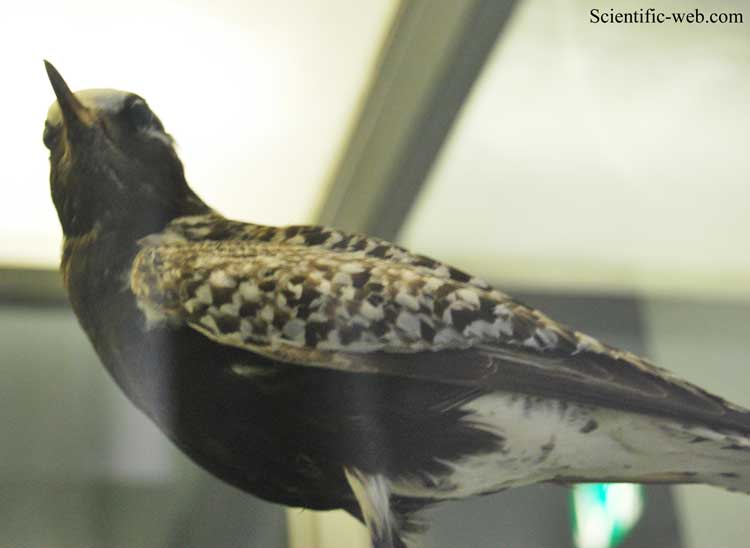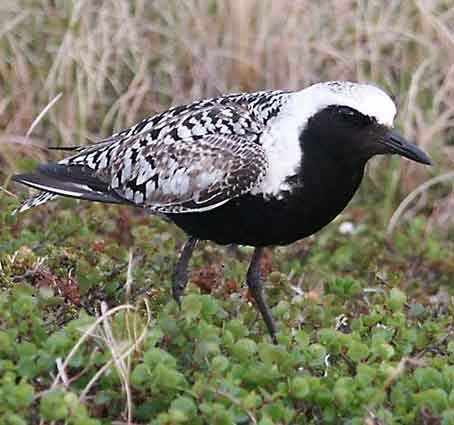
Pluvialis squatarola, Photo: Michael Lahanas
Superregnum: Eukaryota
Cladus: Unikonta
Cladus: Opisthokonta
Cladus: Holozoa
Regnum: Animalia
Subregnum: Eumetazoa
Cladus: Bilateria
Cladus: Nephrozoa
Superphylum: Deuterostomia
Phylum: Chordata
Subphylum: Vertebrata
Infraphylum: Gnathostomata
Megaclassis: Osteichthyes
Cladus: Sarcopterygii
Cladus: Rhipidistia
Cladus: Tetrapodomorpha
Cladus: Eotetrapodiformes
Cladus: Elpistostegalia
Superclassis: Tetrapoda
Cladus: Reptiliomorpha
Cladus: Amniota
Classis: Reptilia
Cladus: Eureptilia
Cladus: Romeriida
Subclassis: Diapsida
Cladus: Sauria
Infraclassis: Archosauromorpha
Cladus: Crurotarsi
Divisio: Archosauria
Cladus: Avemetatarsalia
Cladus: Ornithodira
Subtaxon: Dinosauromorpha
Cladus: Dinosauriformes
Cladus: Dracohors
Cladus: Dinosauria
Ordo: Saurischia
Cladus: Eusaurischia
Subordo: Theropoda
Cladus: Neotheropoda
Cladus: Averostra
Cladus: Tetanurae
Cladus: Avetheropoda
Cladus: Coelurosauria
Cladus: Tyrannoraptora
Cladus: Maniraptoromorpha
Cladus: Maniraptoriformes
Cladus: Maniraptora
Cladus: Pennaraptora
Cladus: Paraves
Cladus: Eumaniraptora
Cladus: Avialae
Infraclassis: Aves
Cladus: Euavialae
Cladus: Avebrevicauda
Cladus: Pygostylia
Cladus: Ornithothoraces
Cladus: Ornithuromorpha
Cladus: Carinatae
Parvclassis: Neornithes
Cohors: Neognathae
Cladus: Neoaves
Ordo: Charadriiformes
Subordo: Charadrii
Familia: Charadriidae
Genus: Pluvialis
Species: Pluvialis squatarola
Subspecies: P. s. cynosurae – P. s. squatarola – P. s. tomkovichi
Name
Pluvialis squatarola (Linnaeus, 1758)
Synonyms
Tringa squatarola Linnaeus, 1758 [protonym]
Squatarola squatarola (Linnaeus, 1758)

Pluvialis squatarola (*)
References
Linnaeus, C. 1758. Systema Naturae per regna tria naturæ, secundum classes, ordines, genera, species, cum characteribus, differentiis, synonymis, locis, Tomus I. Editio decima, reformata. Holmiæ: impensis direct. Laurentii Salvii. i–ii, 1–824 pp DOI: 10.5962/bhl.title.542: 149. Reference page.
Vernacular names
Afrikaans: Grysstrandkiewiet
العربية: الزقزاق الرمادي
asturianu: Pollu Cardexu
azərbaycanca: Tules
беларуская: Сявец
български: Сребриста булка
brezhoneg: Morlivid-aod
català: Pigre gris
čeština: Kulík bledý
Cymraeg: Cwtiad Llwyd
dansk: Strandhjejle
Deutsch: Kiebitzregenpfeifer
ދިވެހިބަސް: Alaka
Ελληνικά: Στακτοπλουμίδι
English: Grey Plover
Esperanto: Arĝenta pluvio
español: Chorlito gris
eesti: Plüü
euskara: Txirri gris
فارسی: سلیم خاکستری
suomi: Tundrakurmitsa
føroyskt: Fjørulógv
français: Pluvier argenté
Frysk: Slykwilster
Gaeilge: Feadóg Ghlas
Gàidhlig: Trìlleachan
galego: Píllara cinsenta
Avañe'ẽ: Mbatuirusu
Gaelg: Feddag ghlass
עברית: חופז-י חופמי מנומר
hrvatski: Zlatar Pijukavac
Kreyòl ayisyen: Plivye vant nwa
magyar: Ezüstlile
հայերեն: Մոխրագույն Քարադր
Bahasa Indonesia: Cerek besar
íslenska: Grálóa
italiano: Pivieressa
ᐃᓄᒃᑎᑐᑦ/inuktitut: Anngilik
日本語: ダイゼン
ქართული: კვათარი
қазақша: Маусымқұс
한국어: 개꿩
lietuvių: Jūrinis sėjikas
latviešu: Jūras ķīvīte
македонски: Сребрен дождосвирец
മലയാളം: ചാര മണല്ക്കോഴി
монгол: Буурал сүвээцагаан
Bahasa Melayu: Burung Rampang Kelabu
Malti: Pluviera Pastarda
Nederlands: Zilverplevier
norsk nynorsk: Tundralo
norsk: Tundralo
polski: Siewnica
پنجابی: گرے پلوور
português do Brasil: Batuiruçu-de-axila-preta
português: Tarambola-cinzenta
rumantsch: Gravarel d'argient
русский: Тулес
slovenčina: Kulík bledý
slovenščina: Črna prosenka
shqip: Gjelëza pikaloshe
српски / srpski: Zlatar pijukavac / Златар пијукавац
svenska: Kustpipare
Kiswahili: Kitwitwi Kijivu
தமிழ்: Sambal Uppukkothi
ไทย: นกหัวโตสีเทา
Tagalog: Matang-baka
Türkçe: Gümüş yağmurcun
українська: Морська сивка
Tiếng Việt: Choi choi xám
中文: 灰斑鸻
The grey plover or black-bellied plover (Pluvialis squatarola) is a medium-sized plover breeding in Arctic regions. It is a long-distance migrant, with a nearly worldwide coastal distribution when not breeding.[2]
Taxonomy
The grey plover was formally described by the Swedish naturalist Carl Linnaeus in 1758 in the tenth edition of his Systema Naturae under the binomial name Tringa squatarola.[3] It is now placed with three other plovers in the genus Pluvialis that was introduced by the French onithologist Mathurin Jacques Brisson in 1760.[4][5] The genus name is Latin and means relating to rain, from pluvia, "rain". It was believed that they flocked when rain was imminent. The species name squatarola is a Latinised version of Sgatarola, a Venetian name for some kind of plover.[6]
The English common name used for this species differs in different parts of the world. It is generally known as "grey plover" in the Old World and "black-bellied plover" in the New World.[7]
Three subspecies are recognised:[5]
P. s. squatarola (Linnaeus, 1758) – breeds in north Eurasia and Alaska; non-breeding in west, south Europe, Africa, south, east Asia and Australasia and west Americas
P. s. tomkovichi Engelmoer & Roselaar, 1998 – breeds on Wrangel Island (northeast Siberia)
P. s. cynosurae (Thayer & Bangs, 1914) – breeds north Canada; non-breeding along coastal North and South America
Description
The grey plover is 27–30 cm (11–12 in) long with a wingspan of 71–83 cm (28–33 in) and a weight of 190–280 g (6.7–9.9 oz) (up to 345 g (12.2 oz) in preparation for migration). In spring and summer (late April or May to August), adults are spotted black and white on the back and wings. The face and neck are black with a white border; they have a black breast and belly and a white rump. The tail is white with black barring. The bill and legs are black. They moult to winter plumage in mid August to early September and retain this until April; this being a fairly plain grey above, with a grey-speckled breast and white belly. The juvenile and first-winter plumages, held by young birds from fledging until about one year old, are similar to the adult winter plumage but with the back feathers blacker with creamy white edging. In all plumages, the inner flanks and axillary feathers at the base of the underwing are black, a feature which readily distinguishes it from the other three Pluvialis species in flight. On the ground, it can also be told from the other Pluvialis species by its larger (24–34 mm, 0.94–1.34 in), heavier bill.[2][8]
Breeding and migration
Their breeding habitat is Arctic islands and coastal areas across the northern coasts of Alaska, Canada, and Russia. They nest on the ground in a dry open tundra with good visibility; the nest is a shallow gravel scrape. Four eggs (sometimes only three) are laid in early June, with an incubation period of 26–27 days; the chicks fledge when 35–45 days old.[2][8]
They migrate to winter in coastal areas throughout the world. In the New World they winter from southwest British Columbia and Massachusetts south to Argentina and Chile, in the western Old World from Ireland and southwestern Norway south throughout coastal Africa to South Africa, and in the eastern Old World, from southern Japan south throughout coastal southern Asia and Australia, with a few reaching New Zealand. Most of the migrants to Australia are female. It makes regular non-stop transcontinental flights over Asia, Europe, and North America, but is mostly a rare vagrant on the ground in the interior of continents, only landing occasionally if forced down by severe weather, or to feed on the coast-like shores of very large lakes such as the Great Lakes, where it is a common passage migrant.[2][8][9]
Behaviour and ecology
Breeding
Young birds do not breed until two years old; they typically remain on the wintering grounds until their second summer.[2][8]
Food and feeding
They forage for food on beaches and tidal flats, usually by sight. The food consists of small molluscs, polychaete worms, crustaceans, and insects. It is less gregarious than the other Pluvialis species, not forming dense feeding flocks, instead feeding widely dispersed over beaches, with birds well spaced apart. They will however form dense flocks on high tide roosts.[2][8]
Status
The International Union for Conservation of Nature (IUCN) has judged that the threat to the grey plover is of "Least concern".[1] It is one of the species to which the Agreement on the Conservation of African-Eurasian Migratory Waterbirds (AEWA) applies.[10]
References
BirdLife International (2019). "Pluvialis squatarola". IUCN Red List of Threatened Species. 2019: e.T22693749A154513104. doi:10.2305/IUCN.UK.2019-3.RLTS.T22693749A154513104.en. Retrieved 11 November 2021.
Hayman, P.; Marchant, J.; Prater, T. (1986). Shorebirds. Croom Helm. ISBN 0-7099-2034-2.
Linnaeus, Carl (1758). Systema Naturae per regna tria naturae, secundum classes, ordines, genera, species, cum characteribus, differentiis, synonymis, locis (in Latin). Vol. 1 (10th ed.). Holmiae (Stockholm): Laurentii Salvii. p. 149.
Brisson, Mathurin Jacques (1760). Ornithologie, ou, Méthode Contenant la Division des Oiseaux en Ordres, Sections, Genres, Especes & leurs Variétés (in French and Latin). Paris: Jean-Baptiste Bauche. Vol. 1, p. 46, Vol. 5, p. 42.
Gill, Frank; Donsker, David; Rasmussen, Pamela, eds. (July 2021). "Sandpipers, snipes, coursers". IOC World Bird List Version 11.2. International Ornithologists' Union. Retrieved 20 November 2021.
Jobling, James A (2010). The Helm Dictionary of Scientific Bird Names. London: Christopher Helm. pp. 311, 363. ISBN 978-1-4081-2501-4.
Poole, A. F.; Pyle, P.; Patten, M. A.; Paulson, D. R. "Black Bellied Plover". Birds of the World. Cornell Lab of Ornithology. Retrieved 23 September 2020.
Snow, D.W.; Perrins, C.M. (1998). The Birds of the Western Palearctic (Concise ed.). Oxford University Press. ISBN 0-19-854099-X.
Dickinson, M.B.; et al., eds. (1999). Field Guide to the Birds of North America. National Geographic. ISBN 0-7922-7451-2.
"Species". Agreement on the Conservation of African-Eurasian Migratory Waterbirds (AEWA). Retrieved 14 November 2021.
Retrieved from "http://en.wikipedia.org/"
All text is available under the terms of the GNU Free Documentation License

